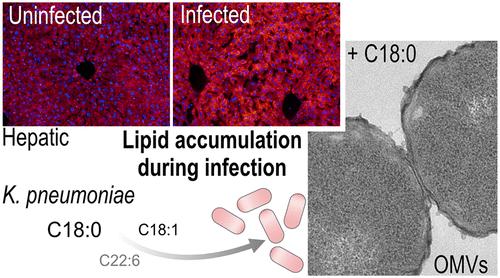Fatty Acid Uptake in Klebsiella pneumoniae and the Landscape of Its Infectious Niches
IF 4
2区 医学
Q2 CHEMISTRY, MEDICINAL
引用次数: 0
Abstract
Klebsiella pneumoniae is consistently ranked among the most problematic multidrug-resistant bacterial pathogens in healthcare systems. Developing novel treatments requires a better understanding of its interaction with the host environment. Although bacteria can synthesize fatty acids, emerging findings suggest a potential preference for their acquisition from the host. Fatty acid profiling of mice revealed a dramatic increase in the level of hepatic lipids during K. pneumoniae infection. The K. pneumoniae fatty acid composition and uptake capabilities were found to be largely clonally conserved. Correlations between fatty acid uptake, outer membrane vesicle production, and cell permeability were observed, but this did not translate to alterations in cell morphology, capsule production, or antimicrobial susceptibility. Importantly, hyper-capsulation did not prevent the uptake of hydrophobic fatty acids. The uptake of a saturated fatty acid by hypervirulent K. pneumoniae isolate may provide insights into the clinical association of K. pneumoniae infections with hyperlipidemic and/or obese individuals.

肺炎克雷伯氏菌的脂肪酸摄取及其感染龛位景观
肺炎克雷伯菌一直是医疗系统中最棘手的耐多药细菌病原体之一。开发新的治疗方法需要更好地了解它与宿主环境的相互作用。虽然细菌可以合成脂肪酸,但新的研究结果表明,细菌可能更喜欢从宿主那里获取脂肪酸。对小鼠进行的脂肪酸分析表明,在肺炎克氏菌感染期间,肝脏脂质水平急剧上升。研究发现,肺炎克氏菌的脂肪酸组成和吸收能力在很大程度上是克隆保守的。观察到脂肪酸吸收、外膜囊泡生成和细胞通透性之间存在相关性,但这并不意味着细胞形态、囊泡生成或抗菌药敏感性发生了改变。重要的是,超囊化并不能阻止疏水性脂肪酸的吸收。高病毒性肺炎克雷伯菌分离株对饱和脂肪酸的吸收可能有助于了解肺炎克雷伯菌感染与高脂血症和/或肥胖症患者的临床关联。
本文章由计算机程序翻译,如有差异,请以英文原文为准。
求助全文
约1分钟内获得全文
求助全文
来源期刊

ACS Infectious Diseases
CHEMISTRY, MEDICINALINFECTIOUS DISEASES&nb-INFECTIOUS DISEASES
CiteScore
9.70
自引率
3.80%
发文量
213
期刊介绍:
ACS Infectious Diseases will be the first journal to highlight chemistry and its role in this multidisciplinary and collaborative research area. The journal will cover a diverse array of topics including, but not limited to:
* Discovery and development of new antimicrobial agents — identified through target- or phenotypic-based approaches as well as compounds that induce synergy with antimicrobials.
* Characterization and validation of drug target or pathways — use of single target and genome-wide knockdown and knockouts, biochemical studies, structural biology, new technologies to facilitate characterization and prioritization of potential drug targets.
* Mechanism of drug resistance — fundamental research that advances our understanding of resistance; strategies to prevent resistance.
* Mechanisms of action — use of genetic, metabolomic, and activity- and affinity-based protein profiling to elucidate the mechanism of action of clinical and experimental antimicrobial agents.
* Host-pathogen interactions — tools for studying host-pathogen interactions, cellular biochemistry of hosts and pathogens, and molecular interactions of pathogens with host microbiota.
* Small molecule vaccine adjuvants for infectious disease.
* Viral and bacterial biochemistry and molecular biology.
 求助内容:
求助内容: 应助结果提醒方式:
应助结果提醒方式:


